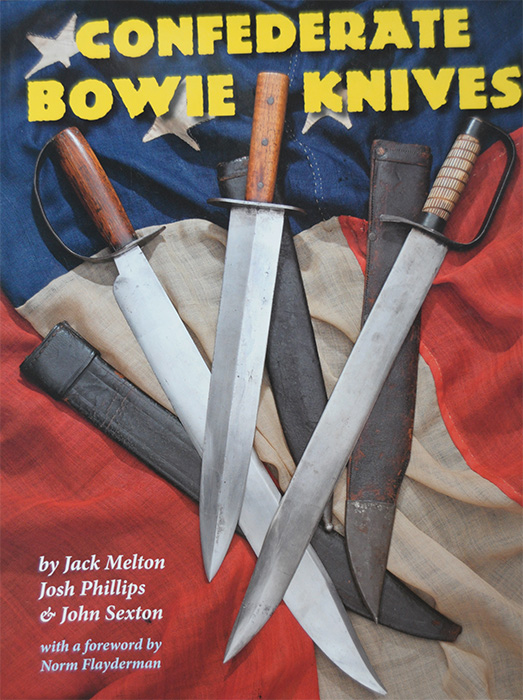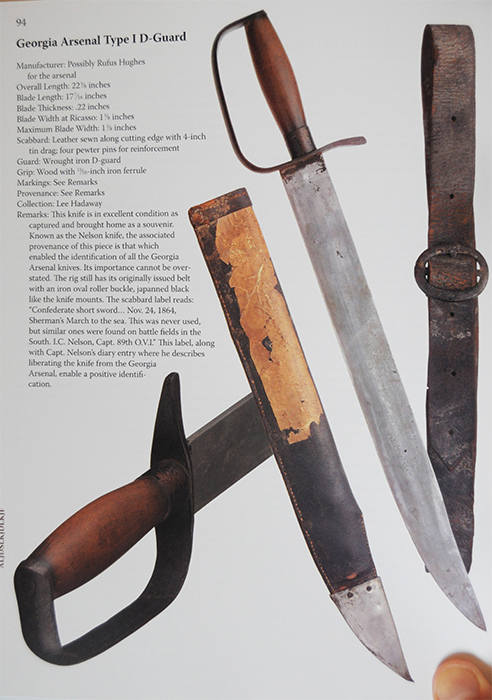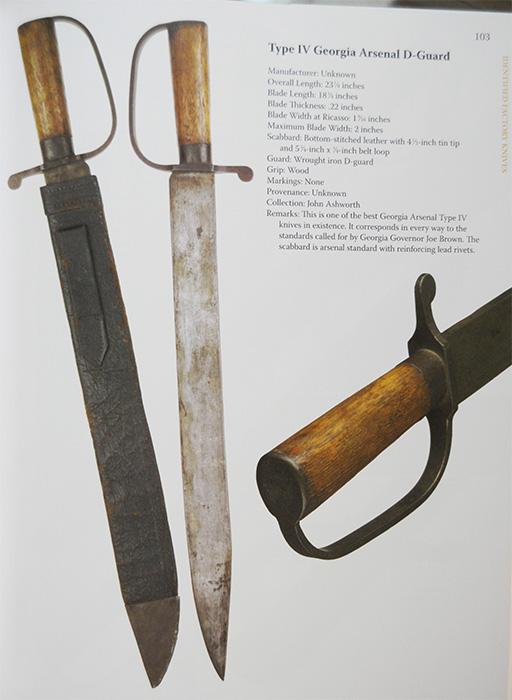Posts: 20
Sat 23 Sep, 2017 7:35 pm
Knife or Cutlass?
So Windlass has this blade I'm pretty interested in. They call it a "D-Guard Bowie Knife", but would it be more correct to consider this a cutlass? I'll leave the stats below, and if anyone knows the technicalities of when a long knife starts being considered a cutlass I'd be interested to hear it.
Cheers!
Overall Length: 23"
Blade Length: 18"
Blade Width: 1-5/8"
Blade Thickness: 3/16"
Weight: 1 lb / 5 oz
P.O.B.: 3 3/16''
http://www.museumreplicas.com/p-1277-d-guard-bowie-knife.aspx
 Attachment: 36.36 KB
Attachment: 36.36 KB
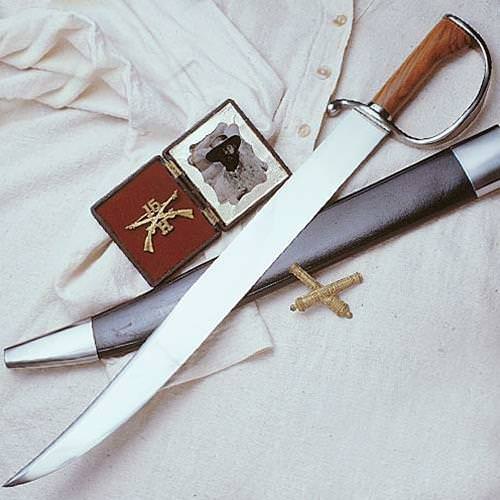
Posts: 1,978 Location: Nipmuc USA
Sun 24 Sep, 2017 2:32 am
Hi Travis
As somewhat a fantasy piece, one could call it whatever they want. It is a better tribute to being a D guard bowie then being called a hunting sword, which is where the term cutlass came from (couteau de chasse). Both might be rather loose in translation though. at a rendezvous and impersonating someone with a cutlass, you might get called out or giggled at. The flair to the handle is not unlike some of the hunting swords but other elements are missing.
I have not read much bad press on the item you link, so quality of build seems good. In real life, a lot of knives that get listed as period ACW D bowies are modern made interpretations and made to fool folk. Windlass does us all a service by selling something that could never be confused with a period piece, while filling a niche for someone's collection.
Cheers
GC
Posts: 2,294 Location: East backwoods-assed Texas
Sun 24 Sep, 2017 6:12 am
I don't really see calling it a cutlass, but I could see it serving about the same purpose. It would be handy on a Civil War Naval vessel, on either side, if combat came ship-to-ship. I'm not all that up on my ACW history, so I couldn't really say if that type of Naval war-time activity was all that common though. I'm pretty sure most Naval battles were fought with gunfire and cannon shot from a distance, so I wouldn't think actual 'boarding' was all that common. And...I could be wrong. That era of history was never a real strong point of my studies.
Travis, I've been eyeing that same weapon for a while myself. It could find a home with my other Bowie's. ;) ....McM
Posts: 675 Location: Louisville, KY
Sun 24 Sep, 2017 6:23 am
I got one of these for my wife's Renaissance Faire Pyrate costume, since it looked to me to be more of a cutlass or hanger short sword. Didn't really say D-gurad bowie to me at all. It works well as a cutlass on her, since she's only 5'3".
 Attachment: 132.63 KB
Attachment: 132.63 KB
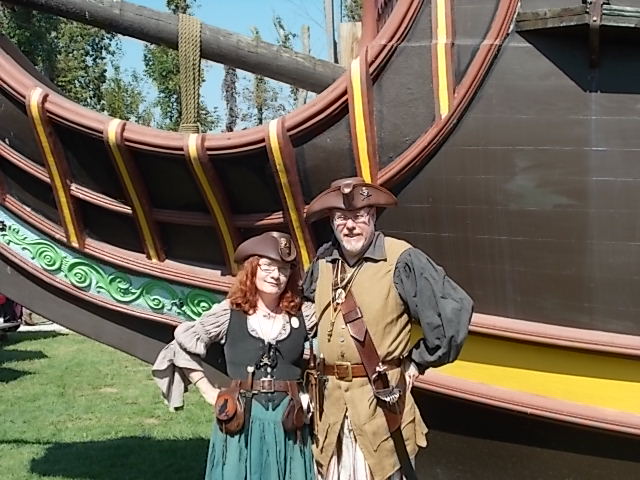
Posts: 345
Sun 24 Sep, 2017 9:40 am
I think it's a little too small for a true cutlass; so far as I can tell most of those had blades in excess of 20 inches (though many hunting swords were much smaller and occupied the same grey area between knife/dagger and sword). And, while it's larger and more refined than any 19th-century D-guard bowie I've seen, the clipped point and simple knucklebow make it difficult to perceive as anything else. I would refer to it as an oversized knife. (Which is, I understand, where the word "cutlass" also comes from.)
Ed.: Mynd you, if it had a side shell, it would be easy to pass off as a miniature cutlass. I had been thinking, when I have the money to spare, to get one for the blade of a Saxon hunting sword, though it may be too broad for that. There's at least one from the latter 17th century with a really broad blade, but it's also got a blunt, almost squared-off point, and I don't know all the parameters of swords from the period.
Last edited by Dan D'Silva on Mon 25 Sep, 2017 7:39 am; edited 1 time in total
Posts: 120
Mon 25 Sep, 2017 3:32 am
Some of those D-guard Bowies carried by Confederates (at least worn for photos) were enormous to the point they resemble a small cutlass. However, every attributed original I have seen were less finished than this reproduction. Many were made by local blacksmiths for young boys wanting to appear more ferocious and manly. Most were traded or discarded once these men started marching and realized that they were practically useless for an soldiering.
Last edited by Paul Mullins on Mon 25 Sep, 2017 11:10 am; edited 1 time in total
Posts: 1,978 Location: Nipmuc USA
Mon 25 Sep, 2017 10:45 am
| Mark Moore wrote: |
I don't really see calling it a cutlass, but I could see it serving about the same purpose. It would be handy on a Civil War Naval vessel, on either side, if combat came ship-to-ship. I'm not all that up on my ACW history, so I couldn't really say if that type of Naval war-time activity was all that common though. I'm pretty sure most Naval battles were fought with gunfire and cannon shot from a distance, so I wouldn't think actual 'boarding' was all that common. And...I could be wrong. That era of history was never a real strong point of my studies.
Travis, I've been eyeing that same weapon for a while myself. It could find a home with my other Bowie's. ;) ....McM |
Not really the case though, as the US navy had established contracts with regulation cutlasses in the early 19th century. It is unlikely you would find a non regulation cutlass on a federal vessel and Confederate cutlasses followed suit with contract cutlasses of their own.
So, romanticizing about what may have gone on during ACW naval battles kind of puts Blackbeard in the same context and timeline, which is not uncommon in many's perspective of what various weapons were. Simply misguided, I guess.
Cheers
GC
Posts: 5,981 Location: Birmingham, Alabama
Mon 25 Sep, 2017 10:55 am
This knife might be in the upper third of quality spectrum of CSA knives. There were better and there certainly were much worse. Design details varied widely. The size isn't too unusual.
Posts: 5,981 Location: Birmingham, Alabama
Mon 25 Sep, 2017 12:32 pm
Posts: 1,241 Location: NC
Mon 25 Sep, 2017 4:34 pm
Early in the Civil War, a lot of newly-minted Confederate soldiers had a tintype taken holding one of these Bowies, along with their musket or pistol. Then a lot of them headed off to war armed with the things. Very early on the soldiers discovered that the opportunities to use these huge knives were very limited and that eliminating the extra weight freed up some energy to carry along something more useful, and they ditched them. That probably accounts for the number that have survived in good shape.
They might do as a cutlass in a pinch but were definitely not intended to be used as a sword.
Posts: 20
Mon 25 Sep, 2017 5:01 pm
Thanks for all the great replies everyone! This was extremely helpful and informative. I'll probably pick one of these up in the near future.
Posts: 1,435 Location: California, Maryland, USA
Wed 27 Sep, 2017 4:32 pm
I may as well - history aside it does look like a neat piece.
M.
Posts: 120
Thu 28 Sep, 2017 3:39 am
Posts: 5,981 Location: Birmingham, Alabama
Thu 28 Sep, 2017 8:15 am
| Dan D'Silva wrote: |
| Sean Flynt wrote: | | Similar knives from this terrific reference: |
Nice. So I take back what I said -- the Windlass bowie does fit, or at least come close to fitting, into contemporary parameters. |
If I had it, I would at least sand the grip. More likely, I would either reshape it or replace it. But there's so much variety, almost anything is plausible. My great-great-grandfather's knife/dagger clearly is made from a saw blade. so, of course, the tang is broken under the grip scales.
Posts: 4,393 Location: Northern California
Thu 28 Sep, 2017 11:50 am
I have this model. It is a solid piece, especially for a Windlass product. It's too long for a knife, too short for a sword, but it would be very useful in enclosed places.
 Attachment: 97.48 KB
Attachment: 97.48 KB
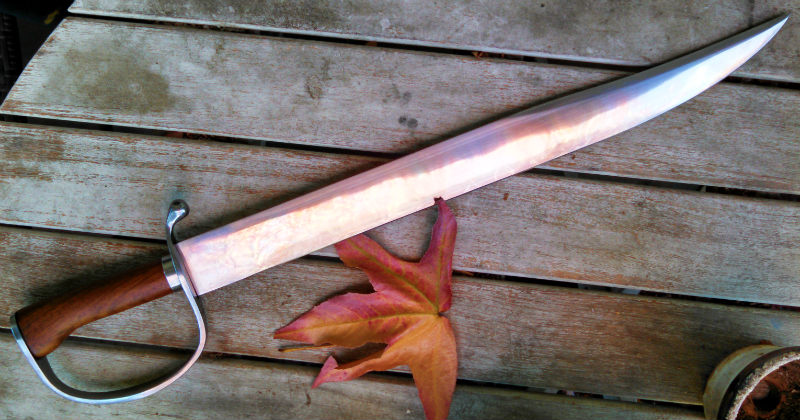
Posts: 20
Thu 28 Sep, 2017 12:19 pm
Wow Rodger Hooper, that blade looks great. Does it come that way or did you adjust it somehow? The steel looks a lot more pale in most pics I've seen.
Posts: 4,393 Location: Northern California
Thu 28 Sep, 2017 12:46 pm
| Travis McLeod wrote: |
| Wow Rodger Hooper, that blade looks great. Does it come that way or did you adjust it somehow? The steel looks a lot more pale in most pics I've seen. |
That is an inadvertent trick that the sunlight and camera played to get that effect. The blade is monochromatic.
Posts: 1,978 Location: Nipmuc USA
Thu 28 Sep, 2017 2:55 pm
| Sean Flynt wrote: |
| Dan D'Silva wrote: | | Sean Flynt wrote: | | Similar knives from this terrific reference: |
Nice. So I take back what I said -- the Windlass bowie does fit, or at least come close to fitting, into contemporary parameters. |
If I had it, I would at least sand the grip. More likely, I would either reshape it or replace it. But there's so much variety, almost anything is plausible. My great-great-grandfather's knife/dagger clearly is made from a saw blade. so, of course, the tang is broken under the grip scales. |
Fascinating. Can you share a picture of your ancestor's knife? How is it possible to tell it came from a saw blade?
Cheers
GC
Posts: 5,981 Location: Birmingham, Alabama
Fri 29 Sep, 2017 7:11 am
This late 19th weapon was made by my great-great grandfather, CSA infantry. Certain elements of the design suggest that it might have been concieved as a fighting dirk. The family tradition is that this was the man's hog-killing knife. It is quite large, with a thin, single-edged blade. Two nail rivets hold the grip to the tang, which is broken near its mid-point. The grip is of a single piece, sawed down the middle but left intact at the top end. Notice the classic dirk elements--the swelling at the top and base of the grip, single edge and symmetrical taper of the convex, triangular blade. The blade is of uniform thickness throughout, suggesting that it may have been made from a broken saw blade, as was common well into the 20th c. (see Foxfire 4:
https://books.google.com/books?id=qNBzxC0U2mQC&pg=PA53&lpg=PA53&dq=Foxfire+knife+from+saw+blade&source=bl&ots=kWcGk2a5W1&sig=v5FhZe2EDlY2bTzwhY8Fm3BuvW0&hl=en&sa=X&ved=0ahUKEwjOg-etysrWAhUIiVQKHWUSC3gQ6AEIOTAG#v=onepage&q=Foxfire%20knife%20from%20saw%20blade&f=false )
Overall Length 13.75 inches
Blade Length 7.25
Grip Length 6 and 3/8 inches
Grip Width 1 and 5/8 inches
Grip Circumference at Center 4. 25 inches
 Attachment: 18.87 KB
Attachment: 18.87 KB

 Attachment: 24.66 KB
Attachment: 24.66 KB
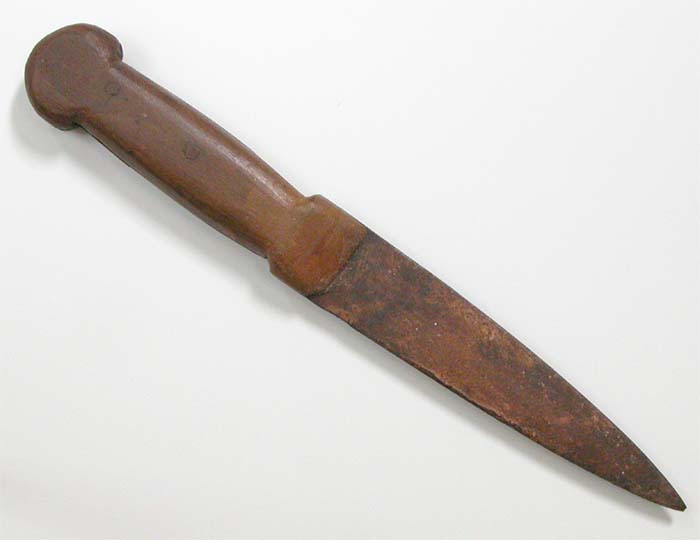
You
cannot post new topics in this forum
You
cannot reply to topics in this forum
You
cannot edit your posts in this forum
You
cannot delete your posts in this forum
You
cannot vote in polls in this forum
You
cannot attach files in this forum
You
can download files in this forum



